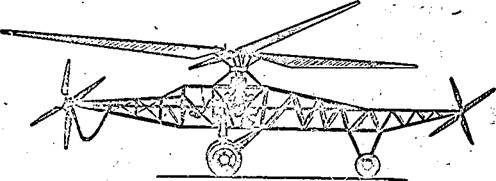PRINCIPLES OF HELICOPTER FLIGHT
§ 1. Brief IWstory of Helicopter Development
і
The idea of creating a flying apparatus with an aerial screw, which ]_3
created a lifting force, was suggested for the first time in 1475 by Leonardo de Vinci. This idea was too premature owing to the impossibility of technical realization of the project and opposition by religious opinions. The idea was buried in the archives. A sketch and description of this flying apparatus was displayed in the Milan library and published at the end of the 19^ century.
In 1754, M. V. Lomonosov substantiated the possibility of creating a heavier than air flying apparatus and built a model of a dual rotor helicopter with the rotors arranged coaxially.
In the 19^ century many Russian scientists and engineers developed projects for flying machines with main rotors. In 1869, electrical engineer A. N. Lodygin proposed a projected helicopter powered by an electric motor.
In 1870 the well known scientist M. A. Rykachev was engaged in the development of propellers.
Metallurgist-scientist D. K. Chernov devised a helicopter scheme with longitudinal, transverse, and coaxially arranged rotors.
Numbers in the margin indicate pagination in the original foreign text.
At the end of the 19^ century, the development of flying machines engaged the attention of the distinguished Russian scientists D. I. Mendeleyev, К. E. Tsiolkovskiy, N. Ye. Zhukovskiy and S. A. Chaplygin. A period of indepth scientific substantiation of the idea of flight with heavier than air flying machines began.
A close associate of N. Ye. Zhukovskiy, B. N. Yur’yev, in 1911 proposed a well-developed single rotor helicopter project with a propeller for directional control and also a fundamental arrangement for helicopter control, that of automatically warping the main rotor. After the Great October Socialist Revolution, when our country began to develop its own aviation industry, work on the creation of a helicopter was continued.
In 1925, in TSAGI, an experimental group for special constructions was organized under the leadership of B. N. Yur’yev This group was engaged in the development of a helicopter.
In 1930 the first Soviet helicopter was built, the TSAGI 1-EA (Figure 1). LA This helicopter was tested by the engineer responsible for its construction, Aleksey Mikhaylovich Cheremyukhin. Cheremyukhin set a world record altitude of 605 m in this helicopter.
|
|
|
Figure 1. TSAGI 1-EA Helicopter. |
In 1948 the single rotor helicopters Mi-1 and Yak-100 were built. As a result of the State trials, the helicopter Mi-1 proved to have the most satisfactory characteristics and it was accepted for mass production.
In 1952 the helicopter Mi-4 was built, which, for that time, had a very large useful load. The same year saw the completion and first flight of the tandem arrangement dual rotor helicopter, the Yak-24, "Flying Wagon" designed by A. S. Yakovlev (Figure 2).
|
|
In 1958 the heavy helicopter Mi-6 was constructed which, up to the J_5_
present time, has no equal abroad.
In 1961 the helicopters Mi-2 and Mi-8 (Figure 3), which have gas turbine engines, were built. At the present time they are in mass production and they will gradually replace the Mi-1 and Mi-4 helicopters.
The ability of a helicopter to fly vertically, and the possibility of motion in every direction, makes the helicopter a very maneuverable flying machine, and since it can operate independent of airfields its boundaries of utilization are considerably widened.
|
Figure 3. Mi-8 single rotor helicopter. |
At the present time helicopters are found in more and more wider application in the national economy. They appear as a basic means of conveyance in locations where it is impossible to utilize ground transport or fixed wing airplanes. Helicopters are utilized in civil construction work and to rescue people and property at times of various natural calamities. Lately helicopters are being widely used in the rural economy. From the examples given, it can be seen that the possibilities of utilizing helicopters as flying machines are far from exhausted.
















